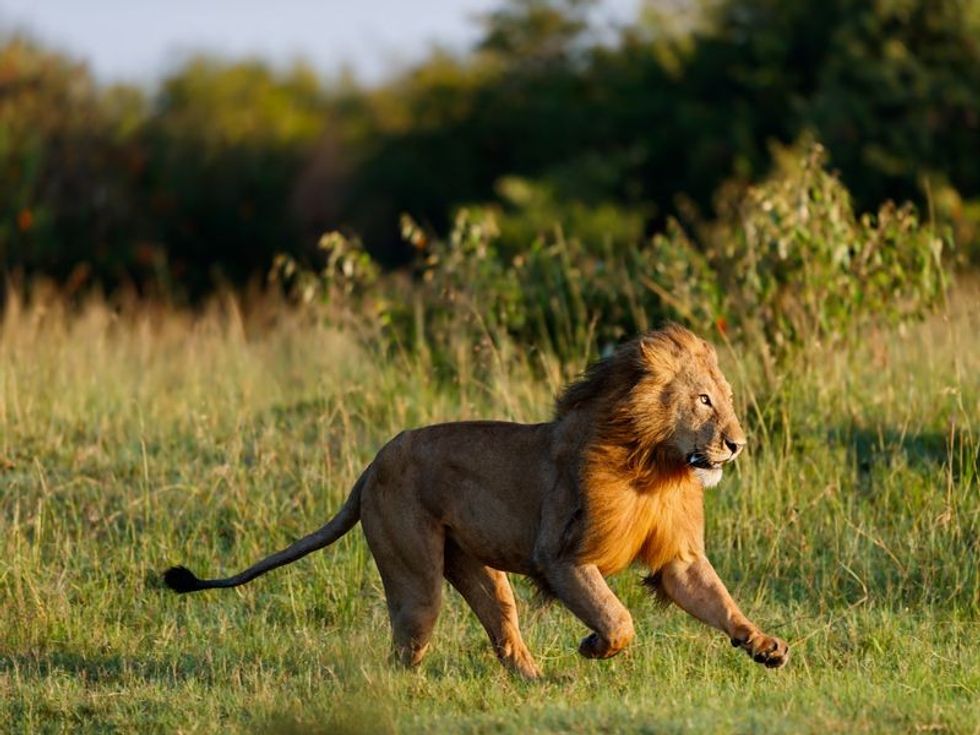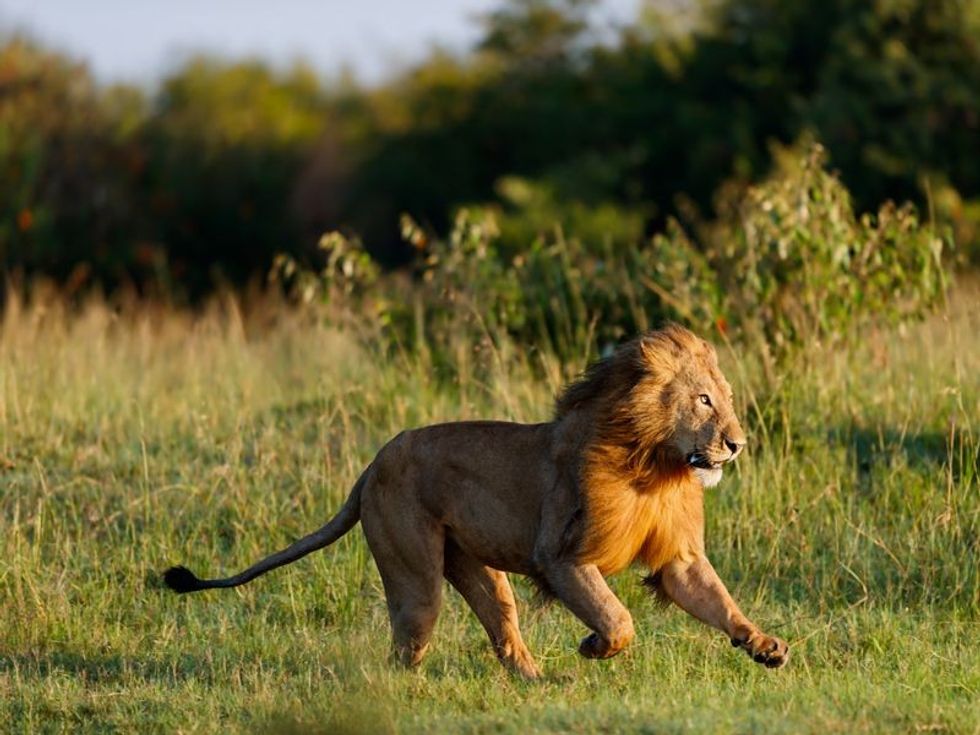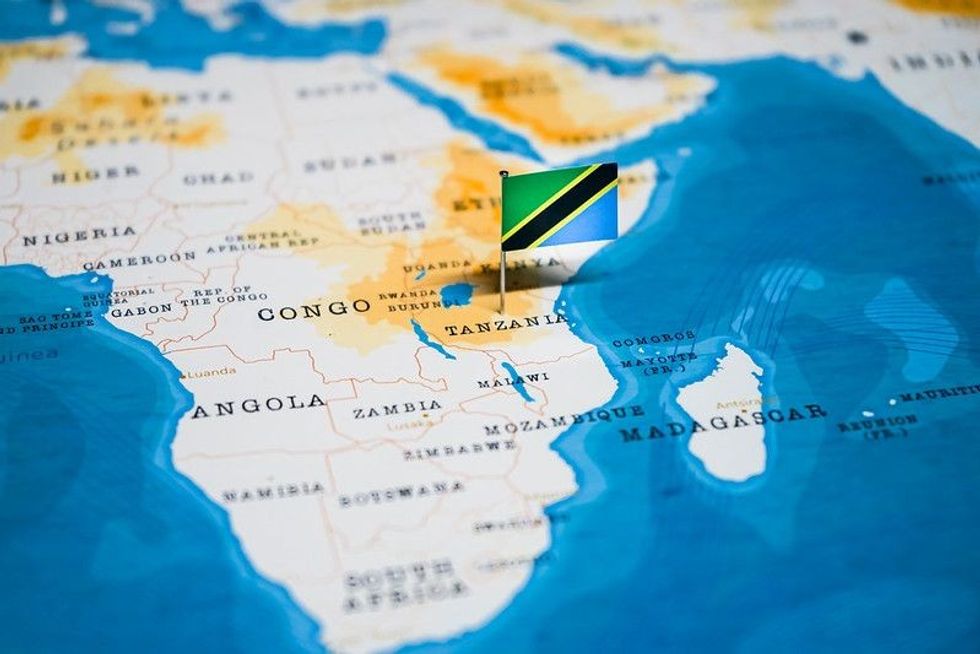The lion, the king of the jungle on Earth, is the most social animal, living in groups of related offspring.
The length of male lions is 72-82 in (184-208 cm) and the length of female lions is 63-72 in (160-184 cm). The tail length of males is 32.5-36.8 in (82.5-93.5 cm) and the tail length of females is 28.3-35.2 in (72-89.5 cm).
The lion (Panthera leo) is a member of a big cat species from India and Africa. The body is deep-chested and muscular with a round head and ears.
There is a hairy tuft present at the end of the lion's tail. Noticeable sexual dimorphism is the predominant mane and larger size of the male compared to the female.
A group of lions is called a pride. Lions' natural habitats are savannas and grasslands.
The conservation status of lions has been listed as Vulnerable since 1996 by the IUCN Red List. It is due to a 43% population decline in African countries. Main threats faced by lions are human confrontations and habitat loss.
Lions prefer hunting mammals like the gemsbok, the giraffe, the plains zebra, the blue wildebeest, and the African wildebeest. Lions can reach a top speed of 50 mph (81 kph), making them the second-fastest land animal in all of Africa.
Lions are usually inactive for almost 20 hours a day to save their energy. Peak activity of these animals can be seen after dusk, which involves grooming, defecating, and socializing.
If you enjoy reading these facts about how fast can a lion run, then make sure to read some more interesting facts about why do lions roar and why do lions have manes here at Kidadl.
Can a human outrun a lion?
No, humans cannot outrun lions.
The top speed of lions is around 50 mph (81 kph), although they do not usually run or chase at this top speed. This speed is almost twice as fast as a human can reach.
If by any chance you do come across a lion, running away is not an option; it will chase you down.
Everyday average speeds of a lion are around 35 mph (56.3 kph), which is still faster than the speed of humans. These big cats can outrun the runner Usain Bolt in a race.
Usually, these wild animals do not hunt human beings, but there have been instances where it has happened. These big cats weigh a lot more than an average human being, and they can reach heights of 4 ft (1.2 m) and lengths of 4.7-8.2 ft (1.4-2.5 m).
These wild, big cats are also known for hunting in groups with around 15 lions. Lions attack and kill around 250 people per year.
When it comes to endurance, humans have the upper hand.
Lions are made for power and speed to chase their prey and not stamina. If a human can run faster than a lion for a short distance, then maybe a human can outrun this wild animal over a long distance.
So, what can you do if you come across a lion? Try not to run, and you must stay calm.
It is necessary to read the mood of the lion. The lion will either be curious or will be thinking about attacking you.
If you notice this animal pawing the ground, then it means that he is not going to attack. However, if you notice the tail sweeping from one side to another, then it shows that the animal feels threatened. If he is still, without moving the tail, then the animal is on the hunt.
This species can sense fear as they usually hunt and outrun weak and scared prey species. If the lion starts approaching you while snorting and growling, then it is trying to size you up.
To show the lion that you are not a threat, you must avoid eye contact and stand sideways. Lions attack only after assessing the prey animal to be of no threat to them.
If the lion does not back down, then you can use intimidation. You will need to make yourself look bigger than this wild animal. You can make use of a backpack or jacket while screaming.
If the lion is standing still, you can take a step or two away from the animal without stopping the noise. The lion might also mock charge at you by running in a zig-zag pattern.
Lions will attack you by holding onto your throat. Make sure to protect your neck.
It is actually safer in the day than at night. These wild animals will most likely attack human beings 10 nights after the full moon.
How far can a lion run at top speed?

At their top speeds, lions cannot run for long distances but only in short bursts.
The underside of a lion's paws have soft pads with retractable claws on each toe, which allows them to run for short distances. It also helps them to catch their prey easily and climb trees.
The structure of the legs and feet allows these animals to jump long distances. The size of the lion's lung and heart is smaller than that of prey animals, which is why they cannot exert themselves.
Their paw pads muffle any sound from their movement. There are extra bones in paws of these animals so they have a wide range of movement.
Lions do not actually reach top speed because it is physically hard for these animals to sustain the pace due to low stamina. This is particularly true when they need to turn and twist while running for short distances.
The habitat around Africa is quite ideal for these animals. These animals need cover sometimes, like when they need to rest or are hunting close to their prey.
Despite being the largest wild cats around the savannas in Africa, lions have sleek body shapes and a balance of stealth and torque. Muscles and tendons of these animals allow them to accelerate at high speeds.
However, exerting this force can tire these animals fast, so they take short bursts of around 50 mph (81 kph) and leap up to 36 ft (11 m) from their hiding spot. A lion's endurance is lesser than that of wild dogs or hyenas.
That is the reason why lions first get as close as they can to their prey and then take a fast leap. For better results, these animals of Africa hunt in groups.
Is a lioness faster than a lion?
Yes, a lioness is faster than a lion.
A lioness is faster than a lion but not is stronger than a lion. While a lion needs to be strong to maintain and protect the territory, the lioness plays an important role.
Lionesses not only care for their cubs but also act as the primary hunter and leader of the pride. African lions are a more social species than any other big cats.
When we compare lionesses to lions, lions might have bigger sizes but the sleek body of lionesses is an advantage while hunting. The mane on the lion protects it and can be intimidating to but it does weigh a lion down in the heat of Africa.
This is another reason why females make great hunters. The lioness provides most of the food to the pride and feeds and cares for her cubs too. Males mostly guard the territory and the pride.
Lions will only hunt when it is absolutely necessary. Lions are lazy most of the day and can be seen resting in shade.
They store this energy to fight off other lions for territories. The rest of the pride takes care of lions as lions need to protect the pride.
The top running speed of the lioness is 45 mph (72.4 kph). A lioness can run at this speed for a short distance because of her slender, sleek, and flexible body type.
A lion, on the other hand, can reach a speed of 35 mph (56.3 kph). Moving his strong and heavy body around makes a lion slower, so the lioness can easily outrun a lion in a race.
Which is the fastest big cat?
Most sources claim that the cheetah is the faster big cat on Earth; however, technically cheetahs do not fall into the category of a big cat, so, that leaves us with a lion as the fastest big cat.
As per researchers and scientists, the big cat category is given to the Panthera genus. There are five species within this genus.
The five species in this group are the lion, the jaguar, the leopard, the tiger, and the snow leopard. However, the snow leopard was a recent classification under Panthera. Some other researchers state that big cats are defined based on their roars.
All species except the snow leopard have a larynx and hyoid apparatus, which allows them to make a loud and deep roar sound. Some also believe that big cats are defined by their long and big size and this would include the lynx, the cougar, and the cheetah into the mix.
Jaguars have the same running speed as lions. Jaguars live in central and South America and are slimmer than lions.
The speed of the leopard is 34.7 mph (56 kph). Leopards can live in almost any kind of habitat. Even though leopards have sleek bodies, their speed is less than that of lions.
Snow leopards have the same speed as lions. Tigers run at a speed of 40.3 mph (65 kph).
A cheetah is not classified within the Panthera genus and is smaller in size and is lighter than all animals in the Panthera genus. A cheetah has dog-like claws that are semi-retractable. A cheetah is the fastest land animal and this type of claw provides traction. Claws of a cheetah can act like a pair of running shoes.
Here at Kidadl, we have carefully created lots of interesting family-friendly facts for everyone to enjoy! If you liked our suggestion for how fast can a lion run, then why not take a look at how much does a lion weigh or lion facts?









